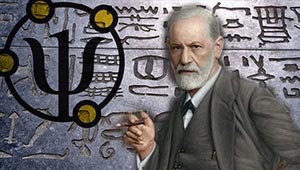Sommario
see the second part see the third part
The most compendious but authentic definition that can be given to love consists of only one word: ‘recovery’.
It is in these terms that Freud expressed himself when speaking about “recovery of the object”.
It would be otherwise difficult to explain the intimate feeling of ‘dejà vecu’, a sensation of completeness and harmony which is always associated with reciprocated love.
Lets say that the most complete and simple formula could be: “Love is an attempt to find resonance and satisfaction in the urging cathexis”.
Freud, listening to his patients, discovered that love is based on infantile prototypes. And he did this through the discovery of the transference in the analytic relationship. Love in the transference is for the patient the repetition of a series of infantile emotional experiences which are real or fantasised; the analysis of these repetitions in the doctor-patient relationship allows the latter to understand which objects and infantile attachments act negatively on his life and adult relationships and allows him to progressively neutralise the conditionings. It is then, with the progressive lowering of the projective pressure (in other terms, with a minor use of the investment on the imagoes of the childhood) that the first true adult object relation begins to emerge on the proscenium of the mind: we begin, as our Master Nicola Peluffo loved to repeat, to “know the object”. 1
• Regression
It is always important to remember that an adult love which is relatively coherent and constant is subject to regression and infantile fixation.
Certainly, understanding this concept could remove much of the drama that we attribute to a loss, realising that, whether we like it or not, the Other is in great part the simulacrum of an infantile love.
When I deal with heartache, one of the greatest sufferances that some psychic structures can suffer, the first goal I set my sights on is to demonstrate that the pain comes from another time and that it has almost nothing to do with the present time and the current relationship.
I do not want to seem cynical, I believe that the loss of a loved one also causes levels of pain which have origin in the loss of the present object, but nothing could force an adult to commit suicide (as sometimes happens) if he did not have an experience of terror which only a child or an abandoned unweaned feels.
This intervention of demonstrating the patients the provenience from beyond the time of their painful experiences, is not as simple as it could seem. A whole series of defensive mechanisms, among which the splitting and the denial stand out, make it extremely difficult.
• Love and Sexuality
As, on the other hand, it is extremely difficult to conceptually separate love from the sexual pressure; The idea comes from a sharp phrase of Freud that he places at the beginning of his Third Essay On The Theory Of Sexuality: “Only the exact convergence of the two urges directed towards the sexual object and the sexual aim, or in other terms, the affectionate drive and the sensual one, assures a normal sexual life“. 2
Freud specifies that in males, upon reaching the puberal maturation, the new sexual aim becomes the emission of sexual products. The previous aim, in other words, the attainment of pleasure, which has accompanied all the previous phases of the development of the libido organisation, is not to him unknown; on the contrary, the climax of pleasure is connected to this final act of the sexual process. Only that now “… the sexual instinct is subordinated to the reproductive function becoming, so to speak, altruistic”.
These are affirmations to which I would like to call the attention of my colleagues as, far too often, the emphasis has been placed on the absolute autonomy of the sexual drive from the sentiment.
Regarding this, Freud, with the efficient metaphors which he often uses, clarifies: “It is like drilling through a tunnel from both ends” intending that the fusion of sentiment and sexual drive facilitate the act and strengthen it in synergy.
In order to feel loved, constancy of the perception of the Self and a solid secondary narcissism are necessary, therefore the loving reciprocity is necessary in a relationship.
As ‘secondary narcissism’ we psychoanalysts intend the elastic activity of being able to withdraw the libido cathexis which we have made on lost objects. But it is only this capability of ‘retaking’ the cathexis and of placing them transitorily again on the Ego that permits the establishing of future relationships.
The capability of finding in a partner ways of elaborating losses or traumas and the establishing of a constant sensation of exclusive intimacy, together with the perception of a solidarity, are important elements of a love relationship.
Love, therefore, is put to use for the vital project after the overcoming of the physiological Primary Narcissism. And so the idea that the expression of such a primary function can be continuously disturbed by a concomitant internal conflict can seem abstruse to us.
First of all, the instinctual pressure for physical contact, fusion and interpenetration, must overcome another pressure, of an opposite sign, inscribed in every organism: the conflict with the Other or the Adversary which happens incessantly on a cellular and immune level. This activity of safeguarding ones very own uniqueness also exists and manifests itself on a psychic level and the unconscious interaction that exists between people allows there to be pressure to eliminate the adversary, deep within each one of us, and very often the partner unconsciously assumes the aspects of the Adversary.
In severe regressions and in certain cases of development arrest the subject is incapable of loving. This incapability is often associated to a primary aggressiveness, hate for oneself and for the object, or even to a terror of emptying, as for instance, happened to a young man who had lost his mother at the age of three. The libido emptying caused by the loss of the object which happened in a symbiotic state had left him an insurmountable terror: every time the sexual pressure drew him near a woman his experience was that of vanishing into the void.
At times love is transferred from the original objects to collective objects and causes: religion, artistic sublimations (intellectual or athletic), pets and interests which are almost exclusively personal. Even though it is difficult to delineate the concept of love, all adult love has both infantile and mature unconscious characteristics and it always manifests the tendency to identify itself with the love object and to idealise it.
Following this brief introduction we will speak above all about the pathological aspects of love, in other words, of the dysfunctional love as it is nowadays trendy to define.
• The loving hyper-excitement, praecox excitation: Cherubino
Cherubino is one of the enigmatic key-characters of the Mozartian Opera “The Marriage of Figaro”. He is the page of the Count and he is affected by praecox excitation, attracted by both the mature Countess and, above all, by the “puberal” Barbarina, the twelve year old daughter of the Count’s gardener.
His erotic ambivalence, in the classic manner of an Eros represented as a child, but also at times with female features, is underlined by the role of a singer (mezzosoprano, despite the male character) as well as the future disguise in the clothes of Susanna, of whom Cherubino is destined to assume the aspect in order to set a trap for the Count, unfaithful spouse, in a typical plot of the eighteenth century ambiguous comedy.
But this is not enough, as later Cherubino will try to harass the same Susanna, the countess’s maid as well as Figaro’s betrothed.
The name is not casual: Cherubim, in fact, in the biblical tradition, are a flock of Angels who are closest to God. And like all Angels they are ambivalent regarding their gender.
Also the name of Barbarina is not casual, the alter-ego as well as the erotic object of excitation, as ‘wild’ counterbalance to the angelic name of Cherubino.
1) Cherubino’s Cavatina: “I don’t know what I am any more, or what I’m doing”:
I don’t know what I am any more, or what I’m doing
Now I’m on fire, now I’m freezing
Every woman makes me change colour,
Every woman makes my heart flutter.
Just the name of love, of delight
Upsets me, and makes my heart flutter,
And I find myself talking of love
From a need I can’t explain.
I talk of love when waking
I talk of love when dreaming,
To the water, to the shadows, to the mountains,
To the flowers, to the grass, to the fountains,
To the echoes, to the air, to the winds,
And the sound of my useless words
Is carried away with them.
And if I don’t have anyone to hear me,
I talk of love to myself!
(NB: the line “I don’t know what I am”, even before “what I’m doing” is significant in underlining the sense of bewilderment, almost losing oneself. Not to mention that final “I talk of love to myself!” which almost reaches narcissism)
We recommend the vision of the videoclip below:
Here the defensive function of the praecox excitation can be seen: the object cannot be the adult. The child and the old lady are, for different reasons, women by half, who can be dominated and do not cause as much fear as a woman who is sexually mature and potentially fertile.
The indetermination of the gender, the transgender, is far from a liberal choice, it is typical of whom cannot assume a defined sexual role: to sustain the existence of a third gender is a delirious affirmation, precisely of whom transforms one’s unconscious desire/phantasy in to reality. The truth is that the assumption of the heterosexual role, remember, the only possibility offered by natural psychobiology to give life to the genome eternalisation is a difficult enterprise since it imposes the progressive renouncement of amounts of narcissistic love.
“ (…) The entire issue can also be read as a metaphor of the different phases of love: Cherubino and Barbarina represent the unripe love, Susanna and Figaro the blossoming love, the Count and Countess the worn out and passionless love, Marcellina and Don Bartolo the mature love (…)” 3
The importance of the character (a certain identification of the young Mozart is perhaps recognisable; it is sufficient to remember the celebrated film “Amadeus” by Milos Forman) is underlined by the celebrity of the arias which regard him: “I don’t know what I am any more, or what I’m doing” (cavatina = self-presentation, scenic debut); “You, ladies, who know what love is”, and the most famous “No more you’ll wander, my amorous little butterfly”.
The latter aria is sung by Figaro to make fun of his rival-friend: Cherubino, in fact, has just been surprised by the Count in his ‘attentions’ towards the Countess. Driven by his jealousy, he flies into a fury and orders the immediate banishment of the page to Seville, where he must enroll as official of his regiment.
2) Cherubino’s Aria “You, ladies, who know what love is”
You, ladies, who know what love is,
Look to see if I have it in my heart!
I’ll tell you what I’m going through,
It’s new to me; I can’t understand it.
I feel a warmth full of desire
That now is pleasure, now is agony.
I freeze, and then feel my soul burning,
—> (editor’s note: again, “Now I’m on fire, now I’m freezing”, see above)
And in another moment go back to freezing.
I look for something beautiful outside of myself,
I don’t know who has it, I don’t know what it is.
I sigh and groan without wanting to,
I quiver and tremble without knowing it,
—> (editor’s note: again themes of the previous aria)
I find no peace night or day,
And yet I like suffering this way!
You, ladies, who know what love is,
Look to see if I have it in my heart!
We recommend the vision of the videoclip below:
That “It’s new to me; I can’t understand it” makes the bewilderment and the exertion evident (in the sense of mental work) which clashes against the pressure towards the pleasure principle, which tends to remain in a narcissistic position of autoerotic investment. If in the term ‘to love’ we intend loving an object different from oneself it is evident that the activity is not innate but it is necessary to accomplish a path to detach oneself from the physiological narcissism/autoeroticism of the early childhood. (I look for something beautiful outside of myself, I don’t know who has it, I don’t know what it is). In the fragment
I feel a warmth full of desire
That now is pleasure, now is agony.
I freeze, and then feel my soul burning
there is the entire strain of the investment object. If it is the external object to warm us we risk impoverishing ourselves of warmth (libido) if the object does not ‘respond’. The investment becomes an emptying which in fragile structures can lead to death.
The theme was well represented in the film “Dangerous Liaisons” 1988, directed by Stephen Frears, based upon Christopher Hampton’s play “Les liaisons dangereuses”. You may remember how the co-protagonist Valmont (played by John Malkovich), instigated by the perverse Marquise de Merteuil (Glenn Close) seduces the simple and disarming Madame de Tourvel (Michelle Pfeiffer), who with her beauty and purity strikes and captivates him, thenceforth abandoning her without any reason obsessively repeating the sentence “It is beyond my control.” The young lady, overcome with pain, humiliation and shame, dies from depression and blood letting.
Cherubino represents, so to speak, the ‘erotic motor’ of the event, the animator of all approaches and betrayals, true or presumed. The amorous excitation which appears in him at a precocious age, in such an unexpected and uncontrollable way, is a new fact of which he does not realise nor intuit the cause. It is energy that emerges from the depths, it is emotional living which knocks arrogantly at the door, leaving him confused and agitated. Energy which he knows not where it comes from nor where it leads, but for which he experiments that sensation of uneasiness and to which, nevertheless, it is wonderful to abandon oneself to, even for a moment. It is the feminine that bursts forcefully into Cherubino’s slender structure, shaking him from his foundations.
From a “Novel in Search of an Author”:
“It happened at my first piano performance. I wasn’t ten yet and, before then, my contact with the piano was completely solitary: but even the presence, in that occasion, of other smaller or older children gave me a certain thrill. Who knows, perhaps for the imminent chance of exhibiting myself and receiving smiles and pleased glances. She was at the most a few years older than me and she had to “start the dance” with three brief Mozart pieces: Minuet, Aria and Canzonetta. She had only just begun, when I started to feel a certain buzz never felt before that I could not explain to myself: perhaps the grace of the music, beyond its execution, perhaps the hem of her skirt that in a slovenly manner moved backwards and forwards with every movement of the pedal, perhaps her humble almost resigned expression.
When she arrived at the Canzonetta based on the popular French motif “Ah vous dirai-je maman” (title which I would have discovered years later), my emotion started to become uncontrollable. I had to begin to distract myself deliberately from the listening and the vision: I begun to look at the ceiling, the teacher and the other children.
When it was my turn to play the Schubert pieces I was still unsettled, so much so to perform rather badly. I was still too distracted by the thought of those happily troubled moments. And I continued to ruminate on them once home. During the night I awoke several times with the motif of the Canzonetta which wouldn’t stop buzzing in my head, together with her face, her casually worn lilac dress, her skirt mischievously pulled up and her introvert gaze.
Everything continued until the day of the performance and even beyond. I felt emotions and upset every time I saw her in the street or I met her at a piano lesson. And still, for a certain time, even during later performances, I was anxious when I met and listened to her.
Even during my adolescent years, I inaugurated my first erotic dream with the notes of a piece played by her. But the girl in the dream was not her and could not be her, so great was the difference between her way of being, introverted and surly, and the girl’s in the dream, so sweetly smiling, welcoming and gracious. I continued to satisfy myself with my memories and phantasies, until one day I saw her with a boy.
They walked arm in arm, with ungraceful pace, speaking and laughing in a way that was almost vulgar: but it was not this that cancelled her from my imagination, as much as the fact that someone else had by now ‘violated her’. Maybe I was looking for nothing more than a pretext to ‘pull me back’ in the courting which, in reality, I had never done. In the meantime another piano student, who was much more capable, began to fascinate me strongly, despite some crooked teeth. But she was sweet with her manners, nice and smiling: hence more similar to the girl in my dream. And how she smiled… and, above all, under her hands, the piano roared like a Ferrari”
… to be continued
Quirino Zangrilli and Alberto Scerrati ©
Translated by Linda De Nardo
Notes:
1 – 1 – Nicola Peluffo, Conoscere l’Oggetto, Scienza e Psicoanalisi, 1st June 2005. 
2 -S. Freud, Three Essays On The Theory Of Sexuality, 1905 
3 – From Wikipedia, (“The Marriage of Figaro”)
Nel 2024 riceve il Premio Accademico d’Onore della Accademia Culturale Internazionale Cartagine 2.0.
Nel 2024 docente ad Almaty – Kazakhstan presso il workshop di psicoanalisi sul tema della violenza, promosso dall’Università di psicoanalisi di Mosca in collaborazione con l’Istituto svizzero di micropsicoanalisi.
Doctor Quirino Zangrilli was born in Fiuggi in 1955. Graduated with honours in Medicine and Surgery in 1980, he practices Psychoanalysis, with intensive method, since 1982. He is author of 72 scientific pubblications. He has attended as speaker or president of session to many national and international scientific Conventions. His book “La vita:involucro vuoto” (Life: empty involucre), published by Borla in 1993, has been in use by the Chair of Dynamic Psychology at Turin’s University since 1994. He is the author and founder of the multimedia review “Psicoanalisi e Scienza” (Psychoanalysis and Science), the most read Italian on line review of psychoanalysis. In 2012 he participated as a Speaker at the Scientific Festival of BergamoScienza. In 2013 he illustrated his research on the maternal-fetal interaction in the Special Session of the XI World Congress of Perinatal Medicine in Moscow with his relation “Intrauterine Imprinting”. He is visiting teacher at Moscow Institute of psychoanalysis and training psychoanalist of Swiss Institute of Micropsychoanalysis.
In 2024 he is a teacher in Almaty – Kazakhstan at the psychoanalysis workshop on the topic of violence, promoted by the Moscow University of Psychoanalysis in collaboration with the Swiss Institute of Micropsychoanalysis.
In 2024 he received the Honorary Academic Award of the Carthage 2.0 International Cultural Academy
Le Le Docteur Quirino Zangrilli est né à Fiuggi en 1955. Diplômé avec mention en Médecine et Chirurgie en 1980, il pratique la psychanalyse depuis 1982, en utilisant une technique intensive. Il est l’auteur de 72 livres et publications scientifiques. Il a participé en tant que conférencier ou président de session à de nombreuses conférences scientifiques nationales et internationales. Son livre “La vie : enveloppe vide”, publié par Borla en 1993, est adopté depuis 1994 par la Chaire de Psychologie Dynamique de l’Université de Turin. En 1994, il a reçu le “Prix national Ciociaria de médecine”. Il a conçu et fondé le magazine multimédia “Psicoanalisi e Scienza”, qui est le magazine de psychanalyse en ligne en italien le plus suivi au monde. (Source : Entireweb, Alexa, Google, Virgilio, Arianna., etc.). En 2012, il a participé en tant que conférencier à la colloque scientifique de BergamoScienza. En 2013, il a exposé ses études sur l’interaction materno-fœtale lors de la session spéciale du XIe Congrès mondial de médecine périnatale à Moscou avec le rapport “Intrauterine Imprinting”. Il est chargé d’enseignement au cours de spécialisation de trois ans en psychanalyse, psychothérapie psychanalytique et consultation psychanalytique à l’Université de Moscou. Il est membre didacticien de l’Institut Suisse de Micropsychanalyse et de la Commission pour la Pratique de celui-ci.
En 2024, il enseigne à Almaty – Kazakhstan à l’atelier de psychanalyse sur le thème de la violence, promu par l’Université de Psychanalyse de Moscou en collaboration avec l’Institut Suisse de Micropsychanalyse.
En 2024, il reçoit le Prix Académique Honoraire de l’Académie Culturelle Internationale Carthage 2.0.
В 2024 году является преподавателем в Алматы – Казахстан на семинаре по психоанализу на тему насилия, проводимом Московским университетом психоанализа в сотрудничестве со Швейцарским институтом микропсихоанализа.
В 2024 был награжден Почетной академической премией Академии Международной Культуры «Карфаген 2.0».












